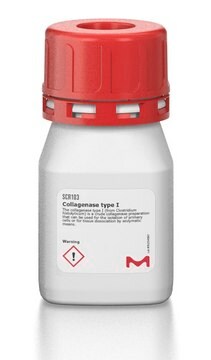추천 제품
Grade
pharmaceutical primary standard
제조업체/상표
USP
응용 분야
pharmaceutical
형식
neat
저장 온도
−70°C
유사한 제품을 찾으십니까? 방문 제품 비교 안내
일반 설명
Collagenase II is a metalloprotease that acts as an endoprotease and exhibits a tripeptidyl carboxypeptidase activity. It shows endopeptidic activity with the main cleavage site found in front of the human collagen duplex amino acids glycine-proline. Hydrolysis takes place in the interior of the triple helical domains of collagen. Collagenase II is also known as class II collagenase and consists of three subtypes: δ, ε, and ζ. Collagenase II USP reference standard is provided as delivered and specified by the issuing Pharmacopoeia. All information provided in support of this product, including MSDS and any product information leaflets have been developed and issued under the Authority of the issuing Pharmacopoeia. For further information and support please go to the website of the issuing Pharmacopoeia.
애플리케이션
- Collagenase Type II for Enhanced Cell Isolation in Biomedical Research: Collagenase Type II is extensively applied in tissue dissociation for isolating cells, crucial for regenerative medicine and tissue engineering. It enables efficient breakdown of the extracellular matrix, facilitating easier cell extraction and purification for use in 3D cell culture and stem cell research. This enzymatic method is invaluable for studies requiring high-purity cell populations, making it indispensable in developing therapies for diseases like Parkinson′s and Alzheimer′s (Park et al., 2024).
- Advancing Tissue Engineering with Collagenase II: In tissue engineering, Collagenase II plays a pivotal role by degrading the collagen matrix in tissues, thereby enabling the cultivation of cells in a controlled environment. This process is essential for constructing tissue structures from the ground up, particularly in developing organoids that mimic natural organ functionalities. The use of high-grade biotech collagenase ensures reproducibility and effectiveness in these sophisticated applications (Wu et al., 2024).
- Collagenase II in 3D Cell Culture Systems: Collagenase II is instrumental in preparing extracellular matrices for 3D cell cultures, which are critical for studying cell behaviors in environments that closely replicate in vivo conditions. This enzyme helps in the accurate study of cellular interactions and pharmacological responses, providing a more realistic assessment of cellular dynamics in medical research (Jiang et al., 2024).
- Role of Collagenase II in Stem Cell Research: Utilizing Collagenase II in stem cell research enhances the isolation and maintenance of stem cells. This is particularly important for applications where the integrity and viability of stem cells are crucial, such as in regenerative medicine and therapeutic cloning. The enzyme′s ability to gently dissociate cells while preserving their functionality makes it a staple in cutting-edge biomedical research (Simón-Pérez et al., 2024).
- Collagenase II for Effective Extracellular Matrix Degradation: The ability of Collagenase II to efficiently degrade collagen-rich extracellular matrices is utilized in various biomedical applications, including cancer research where it aids in tumor microenvironment studies and drug penetration analyses. This enzymatic activity is crucial for understanding the interactions between cancer cells and their surrounding stroma, providing insights into potential therapeutic targets (Mohamed et al., 2024).
생화학적/생리학적 작용
Collagenase is activated by four gram atom calcium per mole enzyme. It is inhibited by ethylene glycol-bis(beta-aminoethyl ether) - N, N, N′,N′-tetraacetic acid, beta-mercaptoethanol, glutathione, thioglycolic acid and 8-hydroxyquinoline.
단위 정의
One collagen digestion unit (CDU) liberates peptides from collagen from bovine achilles tendon equivalent in ninhydrin color to 1.0 μmole of leucine in 5 hours at pH 7.4 at 37 °C in the presence of calcium ions. One FALGPA hydrolysis unit hydrolyzes 1.0 μmole of furylacryloyl-Leu-Gly-Pro-Ala per min at 25°C. One Neutral Protease unit hydrolyzes casein to produce color equivalent to 1.0 μmole of tyrosine per 5 hr at pH 7.5 at 37°C. One Clostripain Unit hydrolyzes 1.0 μmole of BAEE per min at pH 7.6 at 25°C in the presence of DTT.
분석 메모
These products are for test and assay use only. They are not meant for administration to humans or animals and cannot be used to diagnose, treat, or cure diseases of any kind.
기타 정보
This product is part of the USP Biologics program.
신호어
Danger
유해 및 위험 성명서
예방조치 성명서
Hazard Classifications
Resp. Sens. 1
Storage Class Code
12 - Non Combustible Liquids
WGK
WGK 1
Flash Point (°F)
Not applicable
Flash Point (°C)
Not applicable
시험 성적서(COA)
제품의 로트/배치 번호를 입력하여 시험 성적서(COA)을 검색하십시오. 로트 및 배치 번호는 제품 라벨에 있는 ‘로트’ 또는 ‘배치’라는 용어 뒤에서 찾을 수 있습니다.
이미 열람한 고객
Yasin Emre Kaya et al.
Turkish neurosurgery, 30(3), 434-441 (2020-04-03)
To investigate the effects of metformin, a drug used widely for the treatment of type 2 diabetes mellitus, on human primary cell cultures prepared from uninjured segment of disc material intervertebral disk tissues. Primary cell cultures were prepared using the
Michalis Mastri et al.
American journal of clinical and experimental urology, 9(6), 416-434 (2022-01-08)
The evolving paradigm of the molecular classification of bladder cancer requires models that represent the classifications with less heterogeneity. Robust transcriptome based molecular classifications are essential to address tumor heterogeneity. Patient derived models (PDMs) are a powerful preclinical tool to
자사의 과학자팀은 생명 과학, 재료 과학, 화학 합성, 크로마토그래피, 분석 및 기타 많은 영역을 포함한 모든 과학 분야에 경험이 있습니다..
고객지원팀으로 연락바랍니다.








